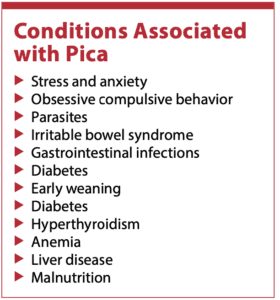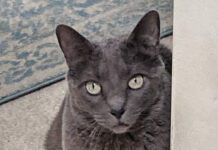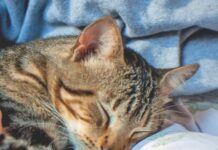At some point in their lives, many cats have swallowed a non-food item by accident when playing. Intentionally seeking out strange things to eat, however, is cause for concern.
“Pica is the persistent ingestion of non-nutritive substances,” says Pamela J. Perry, DVM, PhD, behavior resident at Cornell University’s College of Veterinary Medicine. Cats don’t have the same reputation for chewing on things as dogs, but they still sometimes gnaw on furniture or clothing, especially in their youth. “However, persistently seeking out and consuming inedible items is abnormal,” says Dr. Perry.
 You may or may not notice your cat eating or chewing on non-food items. Other signs that something is amiss include vomiting, diarrhea, constipation, and poor appetite. These symptoms could be due to irritation of the gastrointestinal tract when your cat eats something foolish, or due to intestinal blockage. They can also indicate a variety of other health problems that require veterinary care.
You may or may not notice your cat eating or chewing on non-food items. Other signs that something is amiss include vomiting, diarrhea, constipation, and poor appetite. These symptoms could be due to irritation of the gastrointestinal tract when your cat eats something foolish, or due to intestinal blockage. They can also indicate a variety of other health problems that require veterinary care.
Many different things can cause pica, including genetics. “Pica in cats, especially wool or fabric eating, appears to have a genetic component because it is reported more commonly in Oriental breeds,” says Dr. Perry. This includes Siamese, Burmese, Tonkinese, and Oriental Shorthair cats. If you have a cat or kitten of one of these breeds, keep a watchful eye for any abnormal eating behavior or persistent chewing on and playing with clothing.
“Pica can be due to medical issues, especially those related to the upper gastrointestinal tract,” says Dr. Perry. “Cats also may ingest inedible items because of behavioral disorders, such as anxiety. In some cases, the behavior may be a compulsive disorder.”
Treatment
“The first line of treatment for pica is to have the cat examined for any underlying medical issue,” says Dr. Perry. “If the pica is due to anxiety, then behavior modification and possibly medication may be warranted.”
Any illness that is found during the veterinary workup will be treated accordingly, hopefully causing the pica to go away. If your cat has worms, she will be treated with an appropriate dewormer. Conditions such as inflammatory bowel disease (IBD) may require a diet change and lifelong medications. Your veterinarian may also prescribe a probiotic to help keep your cat’s gastrointestinal tract happy and healthy.
Encourage Proper Eating
Increasing your cat’s interest in proper food items can help with pica. “With cats, I recommend food toys, cat grass, and a higher fiber diet,” says Dr. Perry.
Also, double check that you are feeding your cat a complete and balanced food that is formulated to meet AAFCO nutritional standards (there should be a statement on the food saying it meets these standards). A complete and balanced diet provides your cat with everything that she needs to thrive, and extra fiber will help your cat feel full. This can all help to decrease the desire to eat weird things.
Cat grass and puzzle toys are safe and exciting ways for your cat to snack. The more time she spends eating healthy food and treats, the less time she will spend looking for non-edible items to eat.
Prevent Pica Behaviors
“Environmental management is also very important,” says Dr. Perry. This means preventing your cat from eating anything that might cause harm or enforce bad habits. “I have a cat who eats plastic, so I have to ban all plastic products and anything that resembles plastic.”
Start by figuring out what things your cat chews on or tries to eat. Wool and other fabrics are common items that Siamese and other Oriental cat breeds who have a genetic predisposition to pica may seek out. Other common non-food items include plastic, rubber bands, hair ties, yarn, and pieces of toys.
Once you have identified problematic items, pick them all up and store them so that your cat can’t reach them. Make sure that all clothing is kept in closed dresser drawers or closets, and change out the material of blankets that your cat regularly has access to. Use boxes or drawers to contain rubber bands, hair ties, and other small items.
In some cases, you may need to limit which parts of the house a cat can access. For example, an avid blanket chewer may need to lose bedroom privileges. In extreme cases, confining your cat to a large dog crate when no one is home to supervise her may be necessary.
Make sure that all family members understand your cat’s condition and why it is important to keep her preferred non-food items away from her. This will help to ensure that she only eats food and treats that are safe for her.




